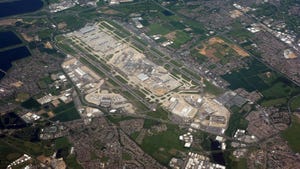Greenpeace: China’s Data Centers on Track to Use More Energy than All of AustraliaGreenpeace: China’s Data Centers on Track to Use More Energy than All of Australia
Environmentalists partner with Chinese academics to call for cleaner energy for the fastest-growing cloud market.

Staying on the current trajectory, cloud data centers in China will consume more energy in 2023 than all of Australia consumed last year.
That’s according to a new report by the East Asian arm of Greenpeace and the North China Electric Power University, a 60-year-old Chinese Ministry of Education institution. The rate of hyperscale cloud platform growth in the country – and the data center footprint to support it – is staggering, but operators of the facilities have done little to reduce their reliance on coal energy, the report, released Monday morning Beijing time, said.
The Chinese data center industry is on track to increase its energy consumption by 66 percent between now and 2023, reaching 267 terawatt-hours that year, the researchers estimated. All homes and businesses in Australia consumed 261 terawatt-hours in 2018, according to the government’s Department of the Environment and Energy.
Coal-fired power plants supplied 73 percent of the 161 terawatt-hours of electricity China’s data centers consumed last year, the report said. Nearly 90 percent of the 44 data centers the researchers studied “sourced power directly from the grid and have not yet taken active measures to procure renewable energy,” a translated summary of the report Greenpeace provided to Data Center Knowledge read. (The original report is in Chinese.)
At the same time, there is more renewable generation capacity in China than in any other country, it pointed out, citing numbers by the International Renewable Energy Agency, an intergovernmental organization and an official United Nations observer.
Greenpeace and the Chinese university researchers based their model for estimating and projecting data center energy consumption in China on many factors, including numbers of server racks, Power Usage Effectiveness (PUE), power and cooling infrastructure design, geographic distribution of the facilities, annual GDP of each province, and so on.
Greenpeace has been calling out tech giants that operate massive data center fleets for using dirty energy since 2010. It started with the likes of Amazon, Facebook, Google, and Twitter, but later added colocation providers like Digital Realty Trust and Equinix to its periodic ‘Clicking Clean’ reports.
This is the first time the organization has focused on data centers in China, an IT services market that’s fairly insulated – increasingly so – but also the world’s fastest-growing. No foreign cloud provider is allowed to operate their own data centers in China, leaving the market wide open for domestic providers, among whom Alibaba Cloud is the dominant player.
Amazon Web Services has the largest market share worldwide, while Alibaba’s efforts to expand its cloud business to international markets have gotten little traction outside of Asia. Yet, Alibaba has the largest public cloud market share in China, which is enough to make it the fifth-largest cloud provider worldwide, according to Synergy Research Group.
Tencent is number-two in the Chinese cloud market, and AWS, whose infrastructure in the country is operated by the domestic provider Sinnet, is in third place. China Telecom if fourth, and China Unicom is fifth, Synergy estimated.
The largest data center landlord to hyperscalers in China is GDS Holdings. The company has been expanding the size of its data center footprint by leaps and bounds, indicative of its biggest clients’ skyrocketing growth. Domestic cloud and internet giants are responsible for about 80 percent of the data center provider’s revenue.
GDS leased about 880,000 square feet of data center space to customers last year and, based on its latest earnings report, it’s on track to at least replicate that success this year. As of the end of this year’s second quarter, the company had 840,000 square feet under construction, more than half of which was already preleased.
The Greenpeace report calls on Chinese data center operators to follow in the footsteps of US hyperscalers and clean up their energy supply by building or investing in wind and solar generation, buying energy directly from renewable generators, and buying “green power certificates,” which are instruments similar to renewable energy credits used in the US. The certificates were introduced in China in a pilot program in 2017.
The report also recommends actions policymakers could take, such as expanding availability of clean power for direct purchase. Today, such products are only available in select pilot markets.
Other recommendations are to expand access to green power certificates by renewable energy projects, to incentivize data center operators to buy renewable energy by removing red tape in the construction-approval process, and to encourage data center construction in central and western China provinces, where there is a surplus of renewable energy resources.
Read more about:
Asia-PacificAbout the Author
You May Also Like







